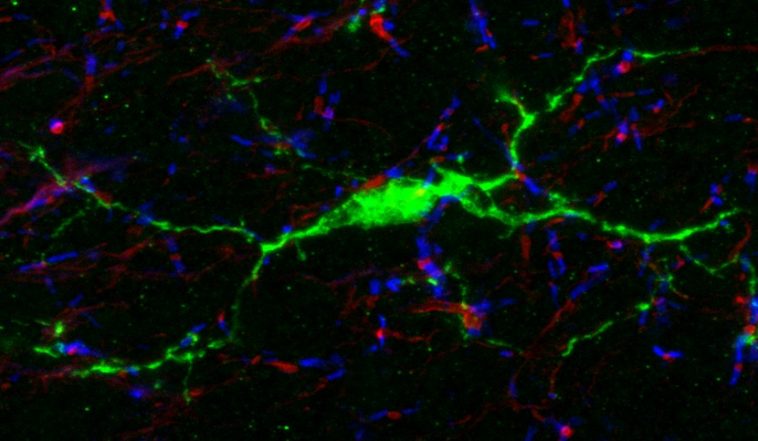A study conducted by Anne Desmazières, Rémi Ronzano and Thomas Roux in Catherine Lubetzki’s team at Paris Brain Institute, shows for the first time a new interaction between neurons and microglia, immune cells present in the brain. This hitherto unknown mode of communication could be key to a better understanding of brain repair mechanisms and pathologies such as multiple sclerosis. The results are published in Nature Communications.
In our nervous system, the transmission of nerve impulses (nerve messages) takes place via the extensions of neurons, the axons, surrounded by an insulating sheath called myelin. The nodes of Ranvier, small domains interspersed between the myelin segments, are essential for the rapid diffusion of information, but they are also a hub of cellular interactions in the brain.
Previous studies have already shown that certain types of brain cells, such as oligodendrocytes and astrocytes, form contacts with neurons at these nodes of Ranvier. However, interactions with another essential brain cell type, microglia, had not been explored. These immune cells play a key role in protecting the brain and in regenerative processes such as remyelination, the reformation of the myelin sheath, which is affected in diseases such as multiple sclerosis.
A study conducted at the Paris Brain Institute by Anne Desmazières and her colleagues Rémi Ronzano and Thomas Roux in Catherine Lubetzki’s team shows for the first time that contacts and communication exist between neurons and microglial cells at the level of the nodes of Ranvier.
Thanks to studies carried out on ex-vivo (tissue culture) and in-vivo mouse models, in particular using real-time imaging approaches to observe the dynamics of these contacts, but also on human tissue, the researchers revealed a particularly stable interaction between these two types of cells, and a reinforced dialogue in a context of myelin regeneration. They also identified the mechanisms underlying this dialogue. Neuronal activity mediates and reinforces the interaction. Microglia are able to ‘read’ the information arriving at the nodes of Ranvier in the form of an ionic signal, thus modulating their state and their interaction with the neuron. Alteration of this ionic signal can keep microglia in a pro-inflammatory state, preventing them from playing their pro-regenerative and pro-remyelinating role.
In the case of multiple sclerosis, this discovery opens up several avenues of research to better understand the disease, in particular the impact of inflammatory signals in this disease on the neuron-microglia dialogue and the pro-remyelinating potential of microglia. The discovery of this dialogue is all the more interesting as therapies being tested in multiple sclerosis are now trying to act on the physiology of these microglia in order to promote their pro-regenerative character.
This new mode of communication also raises the question of the impact of neuronal activity on the behaviour of microglia. Indeed, many neurological pathologies, including epilepsy, are associated with alterations in neuronal activity, and the consequences of this alteration on microglial cells are still unknown.
Source
Microglia-neuron interaction at nodes of Ranvier depends on neuronal activity through potassium release and contributes to remyelination. Ronzano R, Roux T, Thetiot M, Aigrot MS, Richard L, Lejeune FX, Mazuir E, Vallat JM, Lubetzki C, Desmazières A.Nat Commun. 2021 Se







